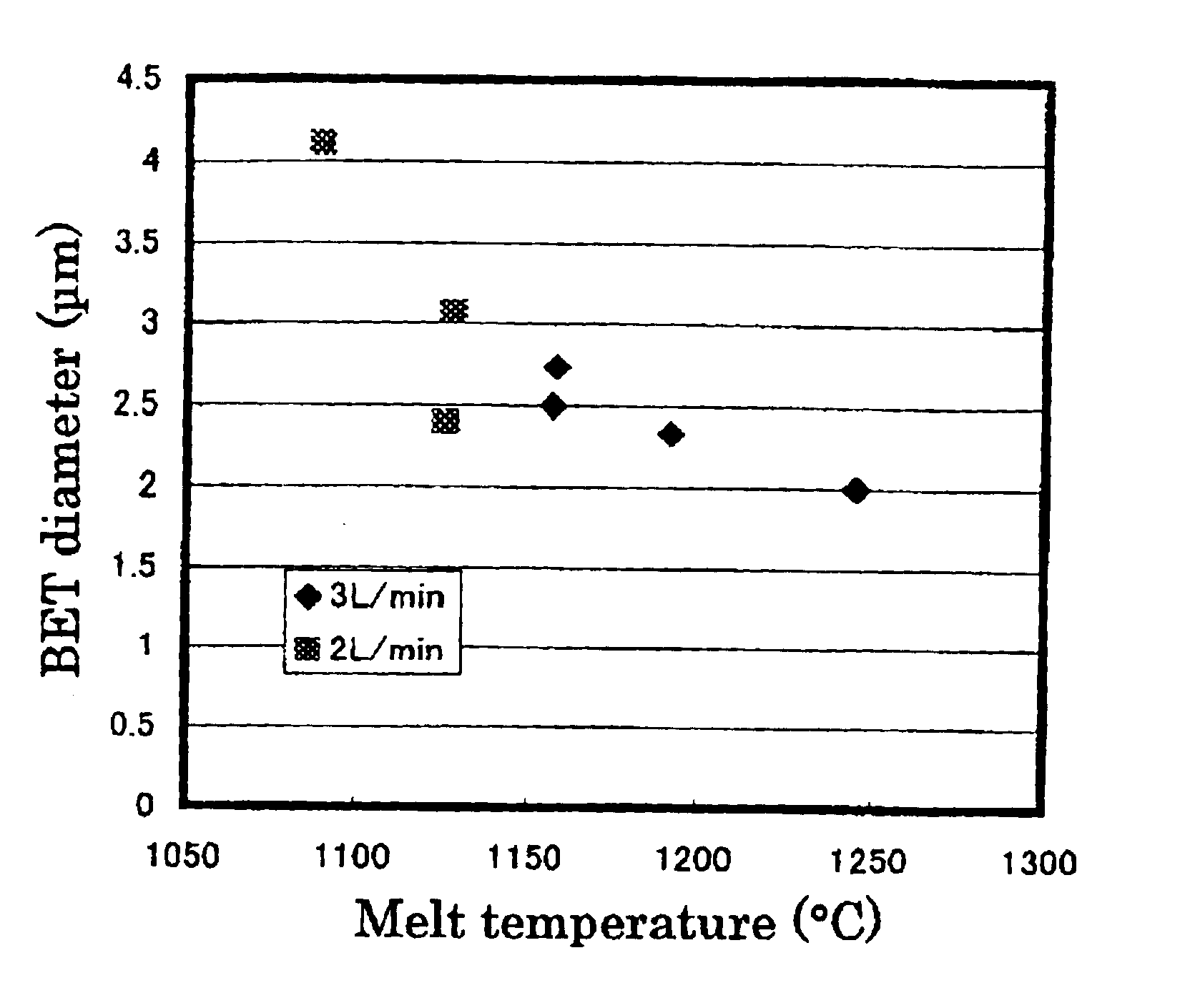Fine powder of metallic copper and process for producing the same
- Summary
- Abstract
- Description
- Claims
- Application Information
AI Technical Summary
Benefits of technology
Problems solved by technology
Method used
Image
Examples
example 1
An alumina crucible (inner diameter: 50 mm) containing high-purity metallic copper was placed in a vertically oriented quartz tube (inner diameter: 70 mm), purged with nitrogen, heated in a resistance-heating type electric oven to melt the copper, and continuously heated to keep the melt at 1200° C. Next, ammonia gas was blew onto the melt surface at 3 L / minute (or 0.15 L / minute per unit area (cm2) of the copper) from a nozzle provided above the molten copper surface. The resulting fine particles were collected by a filter.
The fine particles were confirmed to be of metallic copper by X-ray diffractometry. They were spherical, having a diameter of 0.3 to 7 μm, as observed by a scanning electron microscope (SEM). The BET diameter was 2.9 μm. These fine particles were mostly single-crystalline, the remainder being large single crystals agglomerated with one or more smaller crystals, as found from the SIM image of the FIB-prepared cross-section. It was also found that the particles of 1...
example 2
An alumina crucible (inner diameter: 75 mm) containing high-purity metallic copper was placed in a vertically oriented quartz tube (inner diameter: 95 mm), purged with nitrogen, heated in a resistance-heating type electric oven to melt the copper, and continuously heated to keep the melt at 1230° C. Next, ammonia gas was blew onto the melt surface at 9 L / minute (or 0.20 L / minute per unit area (cm2) of the copper) from a nozzle provided above the molten copper surface. The resulting fine powder was collected by a filter.
The fine particles had a diameter of 0.2 to 4 μm and BET diameter of 1.81 μm. The particles of 4 μm or so in size were partly single-crystalline, and the crystallites were 0.3 to 4 μm in size. In short, it can be considered that these particles are essentially single-crystalline, as is the case with those prepared in EXAMPLE 1.
The fine powder product contained oxygen at 0.2% by weight. It was found that increasing ammonia flow rate decreased size of the spherical, met...
example 3
The fine powder of metallic copper was prepared in the same manner as in EXAMPLE 2, except that the molten copper (melt) was kept at 1160° C. The resulting fine particles had a diameter of 0.2 to 4 μm and slightly larger BET diameter of 2.1 μm. The particles of 4 μm or so in size were partly single-crystalline, and the crystallites were 0.3 to 4 μm in size. In short, it can be considered that these particles are essentially single-crystalline, as is the case with those prepared in EXAMPLE 1. The fine powder product contained oxygen at 0.2% by weight.
The powder production rate was 3.6 g / second·m2, determined from quantity of the metallic copper left in the crucible, and 3.3 g / second·m2, determined from quantity of the recovered fine powder of the metallic copper, both far exceeding the theoretical maximum evaporation rate of 0.36 g / second·m2.
PUM
| Property | Measurement | Unit |
|---|---|---|
| Temperature | aaaaa | aaaaa |
| Percent by mass | aaaaa | aaaaa |
| Diameter | aaaaa | aaaaa |
Abstract
Description
Claims
Application Information
 Login to View More
Login to View More - R&D
- Intellectual Property
- Life Sciences
- Materials
- Tech Scout
- Unparalleled Data Quality
- Higher Quality Content
- 60% Fewer Hallucinations
Browse by: Latest US Patents, China's latest patents, Technical Efficacy Thesaurus, Application Domain, Technology Topic, Popular Technical Reports.
© 2025 PatSnap. All rights reserved.Legal|Privacy policy|Modern Slavery Act Transparency Statement|Sitemap|About US| Contact US: help@patsnap.com


